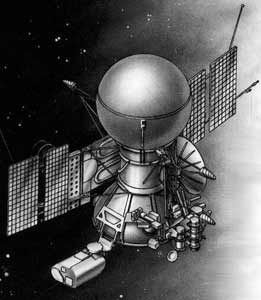
Home - Search - Browse - Alphabetic Index: 0- 1- 2- 3- 4- 5- 6- 7- 8- 9
A- B- C- D- E- F- G- H- I- J- K- L- M- N- O- P- Q- R- S- T- U- V- W- X- Y- Z
Vega 5VK
 Vega lander VeGa-1/2 Venus lander Credit: Andy Salmon |
AKA: 5VK. Status: Operational 1984. First Launch: 1984-12-15. Last Launch: 1984-12-21. Number: 2 . Gross mass: 4,000 kg (8,800 lb).
At Venus a lander with a small balloon would be dropped into the clouds.
Original plans called for two versions, 5VS and 5VP. The 5VP Venus orbiter would be a relay station for a big Soviet-French balloon, to be dropped into the Venusian atmosphere by the 5VP Halley's comet probe as it flew by Venus. In 1981, it was decided to cancel the 5VS orbiters and redesign the 5VP to expand the Halley research program (this may have been in response to the cancellation of the US Halley probe the same year).
On the resulting Vega 5VK spacecraft the big Soviet-French balloon was replaced by a smaller Soviet-built balloon and a Venera 4V-1 type lander (minus camera). The flyby bus was equipped with the same solar panels as the Venera 4V-2 and carried a scan platform with remote sensing instruments to study Halley as well as extra dust protection shields.
The Vega 5VK spacecraft were fitted with scientific apparatus and equipment built in the USSR, Austria, Bulgaria, Hungary, German Democratic Republic, Poland, France, Federal Republic of Germany and Czechoslovakia.
More at: Vega 5VK.
Family: Venus. Country: Russia. Engines: KTDU-425A. Launch Vehicles: Proton, Proton-K/D-1. Projects: Venera. Launch Sites: Baikonur, Baikonur LC200/40, Baikonur LC200/39. Agency: MOM, Lavochkin bureau. Bibliography: 2, 274, 428, 6, 67, 13327.
 | Vega 1 Credit: Manufacturer Image |
1984 December 15 - . 09:16 GMT - . Launch Site: Baikonur. Launch Complex: Baikonur LC200/39. LV Family: Proton. Launch Vehicle: Proton-K/D-1.
- Vega 1 - .
Payload: 5VK s/n 901. Mass: 4,000 kg (8,800 lb). Nation: Russia.
Agency: MOM.
Program: Venera.
Class: Venus.
Type: Venus probe. Spacecraft Bus: 5MV.
Spacecraft: Vega 5VK.
USAF Sat Cat: 15432 . COSPAR: 1984-125A.
Investigations of the planet Venus and Halley's Comet. The APV-V plasma antenna did not deploy until the first mid-course correction burn. Deployed lander and balloon at Venus on June 19 1985. Rendezvoused with comet Halley on March 6, 1986. Fitted with scientific apparatus and equipment built in the USSR, Austria, Bulgaria, Hungary, German Democratic Republic, Poland, France, Federal Republic of Germany and C zechoslovakia.
1984 December 21 - . 09:13 GMT - . Launch Site: Baikonur. Launch Complex: Baikonur LC200/40. LV Family: Proton. Launch Vehicle: Proton-K/D-1.
- Vega 2 - .
Payload: 5VK s/n 902. Mass: 4,000 kg (8,800 lb). Nation: Russia.
Agency: MOM.
Program: Venera.
Class: Venus.
Type: Venus probe. Spacecraft Bus: 5MV.
Spacecraft: Vega 5VK.
USAF Sat Cat: 15449 . COSPAR: 1984-128A.
Investigations of the planet Venus and Halley's Comet. The APV-V plasma antenna did not deploy until the first mid-course correction burn. Deployed lander and balloon at Venus on June 14, 1985. The surface experiments of the lander failed to send back data because they were inadvertently switched on at an altitude of 20 km. Apparently high winds activated a G-force sensor that was to automatically switch on the surface package after the jolt of touchdown. The bus continued in heliocentric orbit and rendezvoused with comet Halley on March 9, 1986. The images of the comet were nearly lost when a television sensor failed shortly before the flyby. A back-up sensor was activated just in time. Fitted with scientific apparatus and equipment built in the USSR, Austria, Bulgaria, Hungary, German Democratic Republic, Poland, France, Federal Republic of Germany and C zechoslovakia.
1985 June 11 - .
1985 June 14 - .
1986 March 6 - .
1986 March 9 - .
Back to top of page
Home - Search - Browse - Alphabetic Index: 0- 1- 2- 3- 4- 5- 6- 7- 8- 9
A- B- C- D- E- F- G- H- I- J- K- L- M- N- O- P- Q- R- S- T- U- V- W- X- Y- Z
© 1997-2019 Mark Wade - Contact
© / Conditions for Use